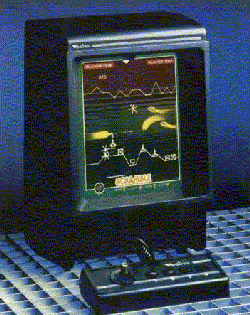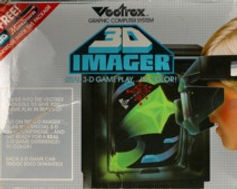
Vectrex is one of the most inspired video game machines ever produced (but similar things were said about the Edsel and Titanic). Its point of distinction is the fact that it uses vector "line" graphics (as opposed to raster "pixel" graphics). This is the same type of screen used in such arcade classics as Space Wars, Asteroids, Battlezone and Tempest. The machine has a 9 x 11 inch black and white screen and comes with a built-in Asteroids clone called Minestorm. The games come with plastic overlays that slide over the screen to cut down on flicker and give some illusion of color. It uses one of the most advanced 8 bit processors, the 68A09 (6809 with 1.5MHz clock speed), and a popular and excellent sound chip, General Instruments AY-3-8912, which can produce a wide range of noises. Also included is a 1.5 inch, self-centering, joystick with 4 buttons on the right. It uses an analog/potentiometer system allowing differing degrees of directional input.
The machine's footprint takes up a little less than a square foot on a desk (in fact, it quite resembles a jet black Macintosh SE sans mouse and keyboard), and can be operated easily in that area. The joystick is connected via a springy telephone-like cord and can be folded into the base of the machine for portability. The machine is moderately transportable and very well constructed but, alas, very much extinct. It made its debut late in 1982 and was quite scarce by the end of 1984 due to the Great Video Game Depression of '82 which forced Milton Bradley (who bought the rights to the Vectrex from General Consumer Electronics (GCE)) to discontinue production due to to poor sales. After this, the rights to the Vectrex and all related materials were returned to the original developers, Smith Engineering. Smith Engineering has graciously condoned the not-for-profit circulation of any duplicatable materials including games and manuals and is happy to see it is still 'alive' in certain circles.
Here are some more detailed snippets from the service manual:
As a general description, the HP3OOO is a self-contained video game system intended for home use. The system includes its own 9" B&W monitor screen and 3" permanent magnet speaker. Plug-in ROM type cartridges are available offering arcade type video and sound game play. No external TV receiver hookup is needed or provided for. A front panel storable controller allows control over the game via joystick and push button action switches. For two player operation a second controller identical to the single player controller is available as an accessory product. Both controllers attach to the main game console through nine wire coiled telephone style cables. There is a consumer power switch/volume control on the front panel as well as a game reset button. A consumer adjustable brightness control is located on the main console rear housing.
The HP3OOO is a microprocessor based, vector scan system using a standard 9" black & white CRT as its video display device. The microprocessor (MPU) is the Motorola 68A09 device. The MPU operates at 1.5 MHz from a 6 MHz external Xtal. An internal divide by 4 circuit generates the MPU 1.5 MHz "E" clock signal used in the system. Program memory is stored in the 8K x 8 bit 2363 type ROM. This ROM contains common subroutines, the "executive" or assembler instructions plus one complete game.
Two 1K x 4 bit 2114 type static RAMs provide storage locations for data indicative of locations of objects, game status, and various other information needed by the microprocessor during game operation. Peripheral Interface Adapter (PIA) Chip, has two 8 bit peripheral ports which interfaces the MPU with peripheral devices and external signals. One of the PIA ports interfaces the General Instrument AY-3-8912 sound-I.O. chip with the MPU and also drives the digital to analog converter chip MC1408. The other PIA port is used as control lines for the sound chip, selector control for the multiplex chip and as a means to read the A/D comparator that's used in the joystick successive approximation circuitry. Sound is either MPU generated directly or by use of the AY-3-8912 sound chip.
The AY-3-8912 sound chip is a programmable sound generator containing 3 tone generators and wave shaping circuitry. This chip also has a single 8 bit I.O. port used to read the status of each of the hand controller's 4 action switches.
The standard TTL device types 74LS00 and 74LS32 are used as control line decoders to allow the MPU to select the appropriate circuit element to be addressed at any particular time.
The analog processing section includes digital to analog converter (DAC) chip type MC1408, dual 4 channel multiplexer/demultiplexer chip type CD4052, and dual channel op-amps types LF353 and LF347.
DAC chip MC1408 receives an 8 bit word at data terminals D0-D7. DAC output (pin 4) is current source. One section of IC LF353 is used to change this current to a voltage representative of the 8 bit digital word received by the DAC chip. The LF353 voltage is applied to an input of the dual 4 channel multiplexer (MUX) chip CD4052. This same voltage (designated "DAC" on the schematic) is the X-axis drive signal.
The CD4052 MUX chip serves two purposes: it selectively couples, under MPU control, the output of the DAC current/voltage converter to one of 4 places and is used to selectively couple the inputs from the joystick pots to the voltage comparator IC LF353.
System variations:
The vectrex system has been released in a number of variations.
- Vectrex US (released by: GCE)
- Japanese Vectrex (released by: Bandai)
- Canadian Vectrex (released by: MB-Canada)
- Vectrex Euro-UK (released by: MB Europe)
- Vectrex Euro-Dutch (released by: MB Europe)
- Vectrex Euro-German (released by: MB Europe)
- Vectrex Euro-French (released by: MB Europe)
- Vectrex Euro-Spanish (released by: MB Europe)
- Vectrex Euro-Italian (released by: MB Europe)
- Vectrex Euro-Swedish (released by: MB Europe)
- Australian Vectrex (released by: MB)
The vectrex had little 'officially released' accessories. The ones that were released, were released towards the end of the system. Therefore, these accessories are hard to come by nowadays. Find below a list of available accessories for the the system:
The 3D Imager (VT 3630):
The 3D-Imager is working a little bit like the new LCD-Shutter Glasses, one eye will be darken and the other can see the picture on the screen. Then the other eye will be darken... But the 3D-Imager darken the eyes with a mechanical round plastic disc with holes in it. This disc is simultaneously a colordisc. This discs are delivered with the 3D-games. The 3D-Imager was only sold in the USA and in a small amount. Today the Vectrex 3D Imager is presumably for collectors the most searched item in the genre of videogames.
The Lightpen (VT 3600):
The lightpen released for the Vectrex allowed you to draw on the screen and came packaged with Art Master, a drawing program. Two other innovative titles were released for the light pen - Melody Master (a music program that allowed you to write notes on the screen and have them played) and Animaction (an animation program). The lightpen was only sold in the US (although I have heard of a shop in The Netherlands who also sold this item, US version).
Additional controller:
An additional controller for the Vectrex was sold seperately. The additional controller was sold in the US (GCE) and Europe (MB).
Carrying case:
A carrying case was released in the US by GCE and in Europe by MB. You could only order the carrying case through the vectrex fan club.
Dust cover:
Like the carrying case, the dust cover could also only be ordered through the vectrex fan club. It is believed to be only released in the US.
(source: vectrex faq, see section docs for complete faq document or see the vectrex faq section)
What is Vectrex?






